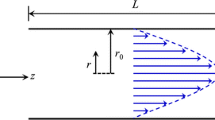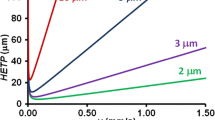Abstract
Now in its sixth decade, size-exclusion chromatography (SEC) remains the premier method by which to determine the molar mass averages and distributions of natural and synthetic macromolecules. Aided by its coupling to a variety and multiplicity of detectors, it has also shown its ability to characterize a host of other physicochemical properties, such as branching, chemical, and sequence length heterogeneity size distribution; chain rigidity; fractal dimension and its change as a function of molar mass; etc. SEC is also an integral part of most macromolecular two-dimensional separations, providing a second-dimension size-based technique for determining the molar mass of the components separated in the first dimension according to chemical composition, thus yielding the combined chemical composition and molar mass distributions of a sample. While the potential of SEC remains strong, our awareness of the pitfalls and challenges inherent to it and to its practice must also be ever-present. This Perspective aims to highlight some of the advantages and applications of SEC, to bring to the fore these caveats with regard to its practice, and to provide an outlook as to potential areas for expansion and growth.



Similar content being viewed by others
References
Striegel AM, Yau WW, Kirkland JJ, Bly DD (2009) Modern size-exclusion liquid chromatography, 2nd edn. Wiley, Hoboken
Wheaton RM, Bauman WC (1953) Ann NY Acad Sci 57:159–176
Porath J, Flodin P (1959) Nature 183:1657–1659
Moore JC (1964) J Polym Sci A 2:835–843
Striegel AM (2005) Anal Chem 77(5):104A-113A
Kilz P, Krüger R-P, Much H, Schulz G (1995). In: Provder T, Barth HG, Urban MW (eds) Chromatographic characterization of polymers—hyphenated and multidimensional techniques. Advances in chemistry series, vol 247. American Chemical Society, Washington, DC, pp 223–241
Schoenmakers P, Aarnoutse P (2014) Anal Chem 86:6172–6179
Ouano AC (1972) J Polym Sci A-1 10:2169–2180
Striegel AM (2020) TRAC Trends Anal Chem 130:115990
Rowland SM, Striegel AM (2012) Anal Chem 84:4812–4820
Boone MA, Striegel AM (2006) Macromolecules 39:4128–4131
Boone MA, Nymeyer H, Striegel AM (2008) Carbohydr Res 343:132–138
Striegel AM, Boone MA (2011) Biopolymers 95:228–233
Morris MJ, Striegel AM (2014) Carbohydr Polym 106:230–237
Meunier DM, Li Y, Gao W (2018). In: Wang Y, Gao W, Orski S, Liu XM (eds) Recent progress in separation of polymers and particulates. ACS symposium series, vol 1281. American Chemical Society, Washington, DC, pp 89–109
Striegel AM, Trainoff SP (2021) Chromatographia 84:37–45
Sinha P, Striegel AM (2019) Anal Chim Acta 1053:186–195
Pasch H (2021) Chromatographia 84:525–530
Viktor Z, Pasch H (2020) Anal Chim Acta 1107:225–232
Pitkänen L, Striegel AM (2016) TRAC-Trends Anal Chem 80:311–320
Berek D (2010) J Sep Sci 33:315–335
Podzimek S (2014) J Appl Polym Sci 40111
Brewer AK (2021) Chromatographia 84:807–811
Podzimek S, Johann C (2021) Chromatographia 84:531–534
Striegel AM (2017). In: Fanali S, Haddad PR, Poole CF, Riekkola M-L (eds) Liquid chromatography: fundamentals and instrumentation, 2nd edn. Elsevier, Amsterdam, pp 245–273
Striegel AM (2017) Chromatographia 80:989–996
Uliyanchenko E, Schoenmakers PJ, van der Wal S (2011) J Chromatogr A 1218:1509–1518
Uliyanchenko E, van der Wal S, Schoenmakers PJ (2011) J Chromatogr A 1218:6930–6942
Striegel AM (2008) J Liq Chromatogr Rel Technol 31:3105–3114
Striegel AM, Isenberg SL, Côté GL (2009) Anal Bioanal Chem 394:1887–1893
Isenberg SL, Brewer AK, Côté GL, Striegel AM (2010) Biomacromol 11:2505–2511
Brewer AK, Striegel AM (2011) Anal Chem 83:3068–3075
Striegel AM (2013) Anal Bioanal Chem 405:8959–8967
Janco M, Alexaner JN IV, Bouvier ESP, Morrison D (2013) J Sep Sci 36:2718–2727
Striegel AM (2014) J Chromatogr A 1359:147–155
Uliyanchenko E, Cools PJCH, van der Wal S, Schoenmakers PJ (2012) Anal Chem 84:7802–7809
Hutchings LR, Pagliarulo A (2021) Chromatographia 84:813–818
Malik MI (2021) Chromatographia 84:1089–1094
Staal WJ (2022) Chromatographia 85:1–5
Kovarik ML (2021) LCGC Blog, August 2 https://www.chromatographyonline.com/view/the-lcgc-blog-polymers-macromolecules-and-nanomaterials-in-the-separation-science-curriculum
Funding
There is no funding to report.
Author information
Authors and Affiliations
Corresponding author
Ethics declarations
Conflict of interest
There is no conflict of interest to report.
Ethical approval
This article does not contain any studies with animals or human participants.
Disclaimer
Commercial products are identified to specify the experimental procedure adequately. Such identification does not imply endorsement or recommendation by the National Institute of Standards and Technology, nor does it imply that the materials identified are necessarily the best available for the purpose. The views expressed in this article are those of the author and do not necessarily reflect the official policy or position of the National Institute of Standards and Technology.
Additional information
Publisher's Note
Springer Nature remains neutral with regard to jurisdictional claims in published maps and institutional affiliations.
Rights and permissions
About this article
Cite this article
Striegel, A.M. Size-Exclusion Chromatography: A Twenty-First Century Perspective. Chromatographia 85, 307–313 (2022). https://doi.org/10.1007/s10337-022-04143-1
Received:
Revised:
Accepted:
Published:
Issue Date:
DOI: https://doi.org/10.1007/s10337-022-04143-1




